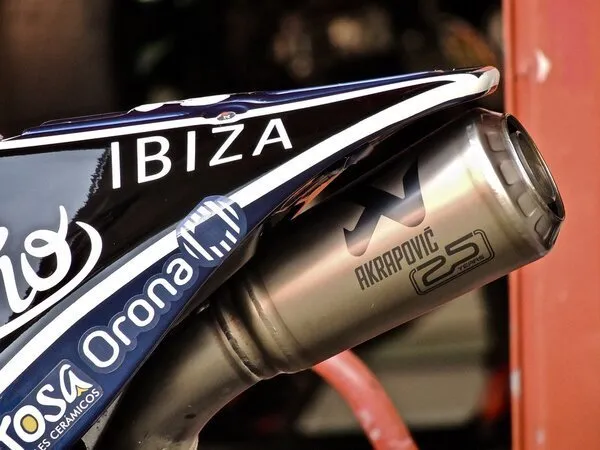Is taking the baffle out bad for a bike? The short answer is yes, but not if you retune the exhaust.
Before we begin, we’d like to talk about the baffle. A baffle is a small perforated metal tube inside your muffler. It performs two essential functions: dampening the noise and generating backpressure.
Engines are noisy. There’s no doubting that. With the right kind of baffle, you can muffle the noise and save yourself and the riders around you from going deaf.
But what about backpressure? Backpressure is essential for keeping a proper air-to-fuel ratio (AFR) in the engine and ensuring timely closure of the intake valve.
So, is it really bad if you take the baffle out? The noise is a significant con. But are there any other problems associated with baffles? We tackle all this and more in our baffle removal guide below.
What’s A Motorcycle Baffle?
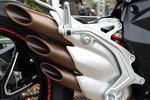
You may have heard the word often, in plumbing or otherwise. But what does it mean in motorcycles?
If you’ve ever had the opportunity to take the muffler of your bike apart, you would have noticed a small perforated inner tube. This tube is called the baffle. Although nothing compared in size to the muffler, the baffle is the most crucial part of a motorcycle’s exhaust.
Baffles perform two main functions: dampening engine noises and creating backpressure. We’ll start with the first bit.
You must have heard how the exhaust is also responsible for silencing engine noises? That’s what the baffle does. But what about backpressure? Backpressure is a resistance to the flow of the exhaust gasses.
There is a brief period during each combustion cycle during which both the intake and exhaust valves are open. This leads to some fuel flowing back through the intake valve. The vacuum created by the backpressure of the exhaust prevents that.
How Do Motorcycle Baffles Work?

So how do motorcycle baffles work? The concept is simple. They resist the flowing gas by creating backpressure (negative pressure). This cancels out the positive pressure, essentially reducing the pressure of the exhaust gases.
Without getting too technical, they maintain a steady flow of exhaust gases. Without a baffle, all the gas would escape the exhaust in powerful bursts, resulting in more noise.
But what about those tiny holes on the baffle? They’re the fundamental structures that dampen the sound. They allow the sound to “break up” across them, much like an acoustic foam panel.
Some shorter baffles have larger holes to make sure they don’t restrict the airflow too much. But longer and bigger baffles commonly have smaller holes. But the underlying principle is the same.
Some mufflers may also have a catalytic converter, which is usually separate from the baffle. It combusts any residual gasses that may be harmful to the environment.
How Do Baffles Affect the Muffler of An Exhaust?
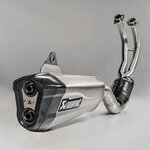
Is taking the baffle out bad for a bike? Baffles are essential for a bike’s exhaust, but how do they affect the muffler? Quite a lot, but positively. When you cut open a muffler, you’ll find two cylinders inside. The outer cylinder is just the muffler housing, nothing special. But the innermost cylinder is the baffle, the beating heart of the muffler.
They’re crucial to a healthy muffler operation. Without a baffle, your muffler won’t be able to perform its most basic function: muffling engine noises.
But baffles also perform another function that goes unnoticed. They produce back pressure against the flow of gasses. At low-to-mid RPMs, this helps pull out more gases from the cylinders.
At low RPMs, your cylinders aren’t able to “pump” the gasses out fast enough. A baffle (and any other backpressure source, such as a bend) creates a vacuum that sucks more of these gasses out.
Is Taking the Baffle Out Bad for a Bike?
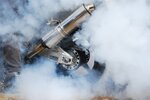
Yes, and in more ways than you think. A motorcycle without a baffle is going to produce a lot of noise. This is not only annoying for most drivers but in some states is also illegal. But that’s not the only way it affects performance.
Removing the baffle may also result in your engine running “lean.” That’s just a technical term for there being too much air in the fuel-air mixture and not enough fuel. This has partly to do with the lack of backpressure in the muffler.
However, aside from these two factors, removing the baffle won’t affect your vehicle. Again, it’s not recommended because your engine will be on the lean side. And your bike will produce a lot of noise, which may even be illegal. But it is possible to remove the baffle without damaging the bike.
One thing to note is that, without a baffle, there will be too much airflow through the exhaust. This can be a good thing in many cases. For instance, when you’re riding at higher RPMs (such as on most performance bikes), then you’ll need faster exhausting. A baffle can get in the way. And on the racetrack or open roads, the extra noise isn’t that big an issue.
Another important point to consider is that baffles also affect the engine’s air-to-fuel ratio (AFR). Without a baffle, the AFR is slightly higher, which affects emission gasses. That means the nature and toxicity of the gasses will be different.
Pros and Cons of Taking Baffles Out of Bike?
So, you’ve decided to remove the baffle from your bike. But is taking the baffle out bad for a bike? Here are the advantages and disadvantages of removing the baffles from your motorcycle:
Pros:
Deeper Sound:
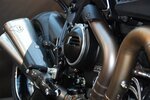
The most obvious advantage of removing the baffles is that the engine’s sound becomes a lot deeper and louder. Now, this can be both a good thing and a bad thing. On the positive side, it shows people that your bike means business. It’s one of the many ways that racers show off on the race track.
But be careful: deeper sound isn’t a preference when riding on the road with other drivers. It is illegal in many states to drive without a muffler. And the constant backfiring from the engine won’t exactly be the safest.
More Airflow:
A baffle is just another obstacle in the way of the exhaust gasses. While at very low speeds, the baffle’s backpressure is suitable for engine efficiency; it restricts airflow at higher speeds. If you own a performance/sportbike and find yourself riding fast quite often, consider removing the baffle.
This will ensure that the exhaust gasses are being vented out from the chambers quickly as they are created. Be sure to put your baffle back on when riding at lower speeds.
Lower Maintenance:
Baffles are relatively weak structurally. They don’t stand the test of time. And since they’re quite hard to repair, you’ll most likely find yourself replacing one if it goes bad. This means more maintenance costs on the bike.
Cons:
More Backfiring:

A backfire is a combustion that takes place outside of the usual combustion chambers. This is how so many professional racers can spew fire from their exhausts. If you’re not an experienced racer or don’t want to play with fire, however, then backfiring is a significant health hazard.
Keeping the baffle on ensures that your engine doesn’t backfire. The airflow is maintained at a steady rate such that the exhaust gasses are never pushed out too forcefully.
Very Loud Sound:
Just as more sound can be a good thing for some people, it can be bad for others. Most people don’t like the sound of a vehicle without a muffler. But it’s not just for yourself. Other drivers can get agitated by the sound and oftentimes temporarily shocked too.
And it’s not just about creating a minor inconvenience. Other riders can’t hear the sounds of oncoming cars and their horns when your engine is all they can hear. And this applies to you as well. This is why it’s even illegal in many states to ride without your muffler.
With that being said, it may be permissible to do so on open empty roads meant for races and the like. Always be sure to check the local guidelines before removing your baffle.
Lower Backpressure:
Baffles are essential for creating backpressure. Backpressure not only helps to dampen the sound and the force with which the gasses are expelled out.
This is important for two reasons. Firstly, if the gasses are expelled too forcefully, they may reach further behind you, blinding the drivers. Secondly, the backpressure creates a vacuum that helps pull more of the exhaust gas out of the cylinders.
Without backpressure, your exhaust will be sputtering out gas with no control whatsoever. And at low RPMs, your engine’s efficiency could be at risk.
At higher RPMs, however, backpressure isn’t much of an issue. It’s best to keep your baffle on if you’re using a bike for commuting or touring.
How Do You Remove Stuck Baffle?
Found your baffle stuck in the muffler and didn’t know how to get it out? While each baffle is designed differently, here are a few general tips on removing a stuck baffle:
Step 1: Wait for The Exhaust to Cool Down
Before you perform any service on the exhaust, you want to make sure it’s cooled down.
Step 2: Unscrew the Bolts
Most baffles are attached to the muffler housing via bolts or screws. Unfasten them using any appropriate tool.
Step 3: Apply Some Lubricant
If the baffle is stuck, you’ll need some lubricant such as WD-40. Spray or apply the lubricant around the edges of the baffle.
Step 4: Use Nose Pliers
Finally, use nose pliers to grab the edge of the baffle and pull it out. Do not yank it. Try to pull it out with minimal force. Then gradually apply more and more force. Apply some more WD-40 if needed and repeat until the baffle is entirely loose.
Alternate Method Using Wires:
If the baffle is too deep into the exhaust and you cannot reach it, then you can use two strong pieces of wire. You can source them from anywhere, such as coat hangers. But make sure they’re tough. Shape the two wires into a sort of hook that will latch onto the holes in the baffle from either side.
Then, grab the wires with your nose pliers and try to pull the baffle out. The length of the wires should be slightly longer than what you need to adjust for any errors.
FAQ
Can removing the muffler from your motorcycle exhaust improve emissions?
Depends on if your muffler has a catalytic converter. If it does, then removing the muffler will most decently make your bike emit toxic combustion gasses. Even if your bike doesn’t have a catalytic converter, removing the muffler can still affect the air-to-fuel ratio (AFR). This will affect the emissions.
Do you have to retune after removing baffles?
Yes, you’ll likely need to retune. If you don’t know, retuning means adjusting the shape and size of the exhaust to maximum engine output. The reflected pressure waves created by the exhaust pipe allow for more air to be sucked into the combustion chamber. Without a baffle, you’ll need to readjust everything, so the engine is working at its optimal efficiency.
Do baffles create back pressure?
Baffles create backpressure. Backpressure refers to the negative pressure created by the baffle. This is against the positive pressure of the outgoing exhaust gasses. Backpressure helps create a vacuum and suck out more exhaust fumes from the combustion and also sucking in more air into the chamber.
Do baffles increase horsepower?
Yes, baffles can increase horsepower and torque. Baffles create backpressure. This sucks the air-fuel mixture into the combustion chamber. And it prevents any from getting lost through the exhaust or intake valves. This increases the efficiency of the engine.
Is taking the baffle out bad for a bike warranty?
If you remove the baffles and something goes wrong, the warranty provider may conclude that the baffles caused it. Read up on your manufacturer’s warranty policy or contact them and ask them about it.
In most cases, any third-party or user interference in any part of the bike will void the warranty. Again, we highly encourage you to check with your service provider as we cannot speak for them.
Conclusion
There you have it. Now you know is taking the baffle out bad for a bike or not. Baffles may be small, but they are no less important than any other component on your bike. You probably already have guessed that they muffle the noise. But we can get you didn’t see the backpressure bit coming.
So, is taking the baffle out bad for a bike? The answer is, yes, unless you retune it. Aside from the noise, which isn’t harmful to the bike itself, the lack of backpressure will lead to a lean engine. It might not be too bad, but your engine will slowly lose its efficiency over time.
If you retune your exhaust, you can enjoy a baffle-free riding experience!

